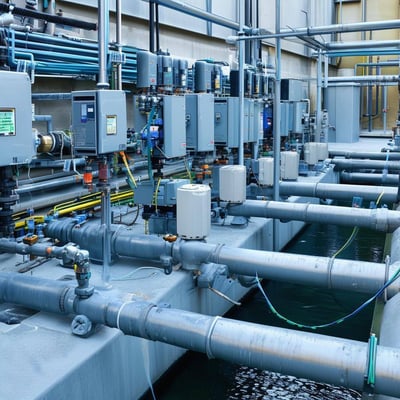
A Comprehensive Exploration of Wastewater Systems
Wastewater management stands as a cornerstone of modern society, safeguarding public health and environmental protection. Wastewater, often referred to as sewage, is the liquid byproduct of human activities, encompassing domestic, commercial, and industrial processes. This effluent carries a myriad of contaminants, including organic matter, suspended solids, and pathogenic microorganisms. To safeguard human health and preserve the delicate balance of our ecosystems, wastewater must undergo rigorous treatment before being reintroduced into the natural environment.
The Wastewater Odyssey: Navigating the Wastewater System
A wastewater system is a sophisticated network of pipes, pumps, and treatment facilities that orchestrate the collection, transport, and purification of wastewater. This elaborate system comprises multiple stages, each meticulously designed to eliminate specific contaminants and transform wastewater into an environmentally safe effluent.
Stage 1: The Collective Effort – The Collection System
The wastewater journey commences at the point of generation, where wastewater is produced from diverse activities such as household chores, industrial operations, and commercial enterprises. This wastewater enters the collection system, an intricate network of underground pipes that serve as the arteries of wastewater management. Gravity plays a pivotal role in propelling wastewater through the collection system, with wastewater flowing effortlessly downhill until it reaches a pumping station.
Equipment Used in the Collection System
- Sewer Lines: These pipes, typically made of concrete or PVC, transport wastewater from homes, businesses, and industrial facilities to the treatment plant.
- Manholes: These vertical access points provide entry into the sewer system for inspection, maintenance, and cleaning.
- Pumping Stations: These strategically located stations lift wastewater from lower elevations to higher elevations, ensuring continuous flow to the treatment plant.
Stage 2: Paving the Way for Purification – Preliminary Treatment
Upon arrival at the wastewater treatment facility, wastewater embarks on the preliminary treatment stage, the initial step in its purification journey. This stage serves as a critical gateway, removing large debris such as rags, sticks, and other solid materials that could impede the flow of wastewater or damage treatment equipment. Screens, grit chambers, and aerated skimming devices are commonly employed in preliminary treatment, ensuring that wastewater enters the subsequent stages relatively free of coarse solids.
Equipment Used in Preliminary Treatment
- Bar Screens: These screens intercept large debris such as rags, sticks, and plastic bags, preventing them from entering the treatment process.
- Grit Chambers: These chambers allow sand, gravel, and other heavy inorganic solids to settle out, protecting pumps and other equipment from damage.
- Aerated Skimming Devices: These devices create a swirling motion that floats grease, oils, and other buoyant materials to the surface for removal.
Stage 3: The Settling of Solids – Primary Treatment
Primary treatment is the pivotal stage where settleable solids, including sand, gravel, and organic matter, are removed from the wastewater. Wastewater enters large settling tanks, where gravity plays a crucial role in separating these solids from the liquid portion. The settled solids, collectively known as sludge, are carefully extracted and undergo further processing for disposal or beneficial reuse. The remaining liquid, now partially clarified, embarks on the next phase of its purification journey – secondary treatment.
Equipment Used in Primary Treatment
- Clarifiers: These tanks provide a quiescent environment for solids to settle out, allowing cleaner wastewater to flow through.
- Sludge Removal Systems: These systems collect and transport the settled solids for further processing and disposal or reuse.
Stage 4: Biodegradation in Action – Secondary Treatment
Secondary treatment marks the biological stage of wastewater treatment, where microorganisms are enlisted to break down organic matter and significantly reduce the levels of harmful pollutants. The activated sludge process, the most prevalent secondary treatment method, involves aerating wastewater to stimulate the growth of beneficial bacteria. These bacteria thrive on organic matter, converting it into carbon dioxide and water, effectively cleansing the wastewater of its organic contaminants.
Equipment Used in Secondary Treatment
- Aeration Tanks: These tanks provide a controlled environment for the growth and activity of microorganisms.
- Diffused Aeration Systems: These systems introduce air into the aeration tanks, providing oxygen for the microorganisms to metabolize organic matter.
- Secondary Clarifiers: These tanks allow the activated sludge to settle out, separating the treated wastewater from the biosolids.
Stage 5: Polishing the Effluent – Tertiary Treatment
Tertiary treatment, also known as advanced treatment, serves as an optional step that provides an extra layer of refinement to the treated wastewater. It is often employed to eliminate specific pollutants that may not be adequately addressed in the primary and secondary stages. Tertiary treatment methods encompass a range of processes, including filtration, disinfection, and nutrient removal, ensuring that the treated effluent meets stringent environmental standards.
Filtration:
Filtration is a physical process that removes fine particles, suspended solids, and residual organic matter from the treated wastewater. Various types of filters are employed, including sand filters, activated carbon filters, and membrane bioreactors.
Disinfection:
Disinfection is a crucial step in eliminating pathogenic microorganisms, such as bacteria, viruses, and parasites, from the treated wastewater. Common disinfection methods include chlorination, ultraviolet disinfection, and ozone treatment.
Nutrient Removal:
Nutrient removal, particularly nitrogen and phosphorus, is essential for protecting sensitive aquatic ecosystems from eutrophication, a condition caused by excessive nutrient levels that can lead to algal blooms and oxygen depletion. Nutrient removal techniques include biological nutrient removal and chemical precipitation.
Equipment Used in Tertiary Treatment
- Filters: Sand filters, activated carbon filters, and membrane bioreactors
- Disinfection Systems: Chlorination systems, ultraviolet disinfection units, ozone generators
- Nutrient Removal Systems: Activated sludge processes, chemical precipitation systems
Conclusion
Wastewater treatment systems play a pivotal role in safeguarding public health and environmental protection. By effectively removing contaminants from wastewater, these systems prevent the spread of disease, protect water resources, and preserve the delicate balance of our ecosystems. As societies continue to evolve and urbanize, wastewater treatment will remain an essential component of sustainable development, ensuring a harmonious coexistence between human activities and the natural world.



